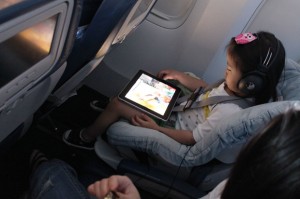 As the holiday season gets fully into gear and 2012 draws to a close, what can we say about the year in in-flight entertainment, and what does the future hold for it?
As the holiday season gets fully into gear and 2012 draws to a close, what can we say about the year in in-flight entertainment, and what does the future hold for it?
It’s certainly been an active year, both for in-flight entertainment and connectivity, with an estimated 1,200 new aircraft being outfitted with either cellular or Wi-Fi connectivity – or, in some cases, both. In addition, Global Eagle acquired Row44 and 86% of the Advanced Inflight Alliance for the sizeable sum of $430 million, Zodiac Aerospace added the IFE capabilities of The IMS Company to its expansive oeuvre of expertise, service providers upgraded their offerings to boost bandwidth and availability, and new aircraft models were line fitted with connectivity in their original factories before being delivered to customers.
And that’s just casually scratching the surface of this year’s developments in the IFEC industry.
With so much going on, it’s easy to get caught up in the now. But what’s the end game here? Or, if not the end game, then the mid-long-term game?
As far as IFE is concerned, industry attention is focused on the potential for wireless IFE systems
That is, an onboard server dishing out its content to personal electronic devices (PEDs) such as tablets, laptops and smartphones which are either brought onboard by passengers or, where tablets are concerned, rented onboard.
There’s a healthy level of excitement focused on the weight and cost savings to be made by offering such a system – particularly if airlines rely on passengers to bring their own devices as opposed to carrying a healthy stock of tablets onboard – but is this really a market that’s going to take off?
Currently, seatback IFE systems seem to be in a state of constant flux. No sooner has an airline analysed its requirements, researched the various options, balanced the books and deployed a new seatback system across some or all of its fleet, than the brand new technology is out-dated and a rival airline is on the cusp of outfitting its own cabins with a larger, faster, more capable system with added bells and whistles.
All of which means that it’s hard work keeping up in an industry that’s already hugely constrained due to the price of fuel, and in which the pace of change is much greater than it has ever been before.
With this in mind, wireless IFE offers a good option as the onus wouldn’t be on airlines to constantly update their seatback IFE systems; that job falls to passengers.
But there are a couple of fairly hefty elephants in the wireless IFE room
The first is early window content. Let’s just say that studios are not going to allow such content to be streamed to passengers’ devices – the piracy risks are too great.
Secondly, as much PEDs are a common site onboard aircraft these days, we’re still a long way from 100% penetration. Are passengers expected to pool devices? What if, with only one device between two people, your wife/brother/son/colleague wants to watch the latest Twilight film and you want to listen to Barry Manilow? Who wins?
In addition, smartphones don’t really make for an immersive tv/movie-viewing experience, so we’re reliant on tablets and laptops in those cases. And what will keep these power-hungry devices stocked full of juice for the duration of the flight?
There are many questions – some will be overcome, either through new approaches, the passage of time etc., but some are likely to persist.
As such, don’t expect to see seatback IFE systems disappearing for at least the next decade. While wireless IFE will certainly make headway – we’re forecasting almost 9,000 aircraft to include such a system by 2021 – it just isn’t viable across a significant portion of the world fleet.
As a closing thought
Surely we can all agree that, as fantastic as modern technology is, nothing beats the excitement created by settling back into your seat and exploring the wondrous delight of the humble seatback IFE system.
















